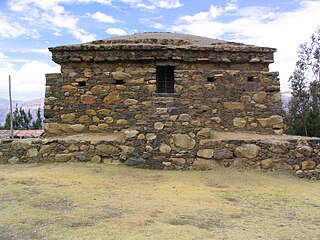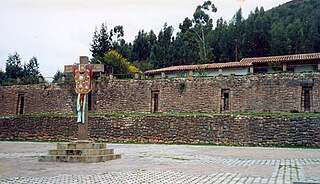
Sacsayhuamán, Sacsayhuaman, Sacsahuaman, Saxahuaman, Saksaywaman, Saqsaywaman, Sasawaman, Saksawaman, Sacsahuayman, Sasaywaman or Saksaq Waman is a citadel on the northern outskirts of the city of Cusco, Peru, the historic capital of the Inca Empire. Sections were first built by the Killke culture about 1100; they had occupied the area since 900. The complex was expanded and added to by the Inca from the 13th century; they built dry stone walls constructed of huge stones. The workers carefully cut the boulders to fit them together tightly without mortar. The site is at an altitude of 3,701 m (12,142 ft).

The Huallanca mountain range (possibly from Quechua, wallanka mountain range; a cactus plant ; also called Chaupi Janca or Shicra Shicra lies in the Andes of Peru. It is located in the Ancash Region, Bolognesi Province. The Huallanca mountain range is a small range southeast of the Cordillera Blanca and north of the Huayhuash mountain range extending between 9°52' and 10°03'S and 76°58' and 77°04'W for about 19 km in a northeasterly direction.
Pukara means a ruin of the fortifications made by the natives of the central Andean cultures.

Huillca Raccay or Huillca Racay is an archaeological site in Peru located in the Cusco Region, Urubamba Province, Ollantaytambo District. It is situated southeast of the archaeological site Patallacta above the right bank of the little river Pampa Qhawa, an affluent of the Vilcanota River, near the village Chamana.

Kikash or Pampash is a mountain in the Wallanka mountain range in the Andes of Peru, about 5,338 m (17,513 ft)) high. It is located in the Ancash Region, Bolognesi Province, Aquia District. It is situated southwest of the main range in a small subrange called Waman Wiqi. There is a small lake named Waman Wiqi southeast of Kikash. The stream Pampash originates on the west side of the mountain,flowing west to the Patiwillka River.

Willkawayin is an archaeological site in Peru. It is located in the Ancash Region, Huaraz Province, Independencia District, in the village of Paria. It is situated at a height of about 3,400 m (11,200 ft).
Mawk'allaqta, also Mawk'a Llaqta is an archaeological site in Peru. It is located in the Puno Region, Melgar Province, Nuñoa District. The site was declared a National Cultural Heritage (Patrimonio Cultural) of Peru by the National Institute of Culture.
Mawk'allaqta, also Mawk'a Llaqta, is an archaeological site in Peru. It is located in the Puno Region, Sandia Province, Sandia District. The site was declared a National Cultural Heritage (Patrimonio Cultural) of Peru by the National Institute of Culture.
Taqrachullu, Pukara Taqrachullu, T'akrachullu, Pukara T'akrachullu or María Fortaleza is an archaeological site in Peru. It is located in the Cusco Region, Espinar Province, Suykutambo District.

Titankayuq is one of the most important habitats in Peru for the Puya raimondii. The woods of Puya raimondii are located in the Ayacucho Region, Vilcas Huamán Province, Vischongo District, at elevations between 3,250 metres (10,663 ft) and 4,250 metres (13,944 ft).

Inti Watana, Intiwatana or Pumaqucha is an archaeological site in Peru. It is located in the Ayacucho Region, Vilcas Huamán Province, Vischongo District, at the lake Pumaqucha.
Inti Watana may refer to:

Colcampata is an archaeological site in Peru. It is situated in the Cusco Region, Cusco Province, Cusco District.
Pukara is an archaeological site in Peru located in the Ayacucho Region, Vilcas Huaman Province, in the south of the Concepción District, near Antap'iti (Antapite). It is situated at a height of about 3,700 metres (12,139 ft) on top of the mountain Pukara (Pucará). This place is also interesting as a natural viewpoint.

Huachuhuilca is a 5,315-metre-high (17,438 ft) mountain in the Huanzo mountain range in the Andes of Peru. It is situated in the Arequipa Region, La Unión Province, Puyca District, southwest of Lake Ecma.
Hatun Usnu is an archaeological site in Peru on a mountain of the same name (Jatunhosno). It is located in the Ayacucho Region, Huamanga Province, Chiara District.

Tinyaq or Quri Willka is an archaeological site in Peru with storehouses of the Inca period on a mountain named Tinyaq. It is located in the Ayacucho Region, Huanta Province, Iguain District.
Hatun Misapata or Misapata is an archaeological site in the Ayacucho Region in Peru. It was declared a National Cultural Heritage by Resolución Viceministerial Nº 459-2011-VMPCIC-MC of April 20, 2011. Hatun Misapata is situated in the Lucanas Province, Aucara District.
Wamanilla or Misayuq Pata is an archaeological site in the Ayacucho Region in Peru. It was declared a National Cultural Heritage by Resolución Viceministerial Nº 459-2011-VMPCIC-MC of April 20, 2011. It is situated in the Huanca Sancos Province, Sacsamarca District, and in the Víctor Fajardo Province, Huancaraylla District.
Llaqta Qulluy is an archaeological site in Peru. It is situated in the Huancavelica Region, Huancavelica Province, Vilca District. Llaqta Qulluy was declared a National Cultural Heritage (Patrimonio Cultural).













